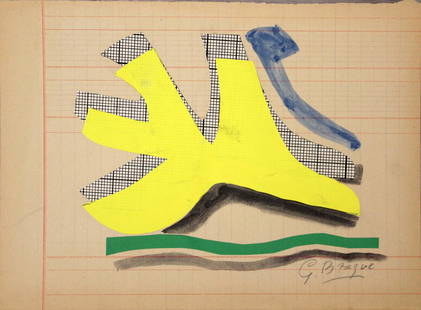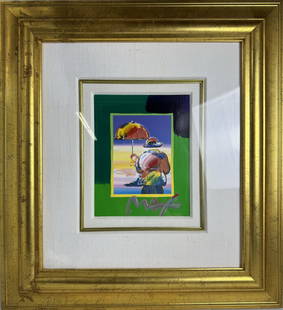
18th C. Catesby "Le Cocq du Bois Amerique" Engraving
Similar Sale History
View More Items in Mixed Media & Collages


Related Mixed Media & Collages
More Items in Mixed Media & Collages
View MoreRecommended Art
View More





Item Details
Description
Mark Catesby (British, 1683-1749), "Le Coq Du Bois D'Amerique (Partridge)", a hand colored copper plate engraving on fine laid paper, from Johann Michael Seligmann (1720-1762) (editor and engraver). A remarkable image from Catesby's "The Natural History of Carolina, Florida, and the Bahama Islands" - one of the most famous color-plate books illustrating American plant and animal life forms, an original work for the study of various American species - published in "Natural History Art, Birds, Ducks, Catesby," Seligmann Edition, ca. 1770s. An important work on paper from the most impressive illustrated study of natural history created during the colonial period of America. Indeed many regard Catesby's work as the most significant work of American natural history prior to Audubon's "Birds of America"! Size: 12.5" L x 9.25" W (31.8 cm x 23.5 cm); 21.25" L x 18" W (54 cm x 45.7 cm) with custom double mat and framing
Catesby trained as a botanist, and in 1712 traveled to Virginia where he resided for seven years, all the while sending collections of seeds and plants to London. Encouraged by Sir Hans Sloane and other experts, Catesby returned to America in 1722 where he travelled extensively throughout the Carolinas, Georgia, Florida, and the Bahamas, gathering specimens for his "Natural History". In the preface of his book, Catesby describes his process, including his important decision to study with Joseph Groupy so that he could learn how to engrave his plates in order to guarantee accuracy.
Arader Galleries has featured this engraving published in Catesby's "The Natural History of Carolina, Florida, and the Bahama Islands" - London, 1731-43. (first edition), 1754 (second edition), 1771-1810 (third edition) - for $6800 - https://aradergalleries.com/products/mark-catesby-1683-1749-le-coq-du-bois-damerique-partridge-p-t1
Arader writes, "In 1712, the English-born artist and naturalist Mark Catesby embarked on a series of expeditions to the southern colonies of British North America. Catesby was enthralled by the wildlife of the New World, and he spent years traveling by foot through parts of present-day Virginia, Georgia, the Carolinas and the Bahamas. Over the course of his journeys, he encountered and documented uncountable varieties of animal and plant life that were entirely unknown to Europeans. His drawings and written observations were the raw material for an unprecedented project: a scientific account of previously uninvestigated wildlife, with illustrations taken from life.
Catesby initially encountered some difficulty in interesting sponsors in his monumental Natural History. Determined nonetheless to persevere in his project, and also wishing to maintain control over the translation of his drawings into print, the artist learned to engrave copper plates and set out to complete the Natural History himself. He produced all but two of the plates, and painted the impressions himself to further insure their fidelity to his models. The result was the most sweeping, complete and unique natural history study ever done. Despite Catesby's initial difficulties in finding subscribers, his striking finished product received widespread acclaim. Cromwell Mortimer, Secretary of the Royal Society, declared the publication to be "the most magnificent work I know since the Art of printing has been discovered." Catesby's charming, distinctive style sets his work apart from all artists who later followed his example. The overt simplicity of his compositions is deceiving; the artist arranged each of his images with great care, often combining seemingly incongruous elements to create the most artful scene possible. A sense of Catesby's enthusiasm for his subjects is palpable in his engravings.
Very few artists were so personally involved in the completion of a published work, and Catesby's images convey what the artist must have experienced in America: the colors and varieties of the exotic species of birds, fish, animals, insects and plants of the New World. Widely considered the great achievement of 18th-century art and science, Catesby's Natural History of Carolina, Florida and the Bahama Islands has lost none of its power to delight in the 250 years since its publication. This remarkable study of American plants and animals is a monument to Catesby's intelligence, scientific devotion and love of nature. The Natural History has provided an important model for ornithologists and scientists, including John James Audubon, who followed in Catesby's footsteps a century later.
Provenance: private Lucille Lucas collection, Crested Butte, Colorado, USA
All items legal to buy/sell under U.S. Statute covering cultural patrimony Code 2600, CHAPTER 14, and are guaranteed to be as described or your money back.
A Certificate of Authenticity will accompany all winning bids.
We ship worldwide to most countries and handle all shipping in-house for your convenience.
#136786
Catesby trained as a botanist, and in 1712 traveled to Virginia where he resided for seven years, all the while sending collections of seeds and plants to London. Encouraged by Sir Hans Sloane and other experts, Catesby returned to America in 1722 where he travelled extensively throughout the Carolinas, Georgia, Florida, and the Bahamas, gathering specimens for his "Natural History". In the preface of his book, Catesby describes his process, including his important decision to study with Joseph Groupy so that he could learn how to engrave his plates in order to guarantee accuracy.
Arader Galleries has featured this engraving published in Catesby's "The Natural History of Carolina, Florida, and the Bahama Islands" - London, 1731-43. (first edition), 1754 (second edition), 1771-1810 (third edition) - for $6800 - https://aradergalleries.com/products/mark-catesby-1683-1749-le-coq-du-bois-damerique-partridge-p-t1
Arader writes, "In 1712, the English-born artist and naturalist Mark Catesby embarked on a series of expeditions to the southern colonies of British North America. Catesby was enthralled by the wildlife of the New World, and he spent years traveling by foot through parts of present-day Virginia, Georgia, the Carolinas and the Bahamas. Over the course of his journeys, he encountered and documented uncountable varieties of animal and plant life that were entirely unknown to Europeans. His drawings and written observations were the raw material for an unprecedented project: a scientific account of previously uninvestigated wildlife, with illustrations taken from life.
Catesby initially encountered some difficulty in interesting sponsors in his monumental Natural History. Determined nonetheless to persevere in his project, and also wishing to maintain control over the translation of his drawings into print, the artist learned to engrave copper plates and set out to complete the Natural History himself. He produced all but two of the plates, and painted the impressions himself to further insure their fidelity to his models. The result was the most sweeping, complete and unique natural history study ever done. Despite Catesby's initial difficulties in finding subscribers, his striking finished product received widespread acclaim. Cromwell Mortimer, Secretary of the Royal Society, declared the publication to be "the most magnificent work I know since the Art of printing has been discovered." Catesby's charming, distinctive style sets his work apart from all artists who later followed his example. The overt simplicity of his compositions is deceiving; the artist arranged each of his images with great care, often combining seemingly incongruous elements to create the most artful scene possible. A sense of Catesby's enthusiasm for his subjects is palpable in his engravings.
Very few artists were so personally involved in the completion of a published work, and Catesby's images convey what the artist must have experienced in America: the colors and varieties of the exotic species of birds, fish, animals, insects and plants of the New World. Widely considered the great achievement of 18th-century art and science, Catesby's Natural History of Carolina, Florida and the Bahama Islands has lost none of its power to delight in the 250 years since its publication. This remarkable study of American plants and animals is a monument to Catesby's intelligence, scientific devotion and love of nature. The Natural History has provided an important model for ornithologists and scientists, including John James Audubon, who followed in Catesby's footsteps a century later.
Provenance: private Lucille Lucas collection, Crested Butte, Colorado, USA
All items legal to buy/sell under U.S. Statute covering cultural patrimony Code 2600, CHAPTER 14, and are guaranteed to be as described or your money back.
A Certificate of Authenticity will accompany all winning bids.
We ship worldwide to most countries and handle all shipping in-house for your convenience.
#136786
Condition
Normal toning to paper with slight foxing in areas, but otherwise excellent. Has not been examined outside of the frame.
Buyer's Premium
- 24.5%
18th C. Catesby "Le Cocq du Bois Amerique" Engraving
Estimate $1,500 - $2,500
2 bidders are watching this item.
Get approved to bid.
Shipping & Pickup Options
Item located in Louisville, CO, usSee Policy for Shipping
Payment

TOP





































![Jean Edouard Vuillard "Le Jardin" Mixed Media: Jean Edouard Vuillard (French, 1868-1940), "Le Jardin" [The Garden], Mixed Media on Paper, circa 1910, pen, ink, and crayon, initials stamped lower right, Wolseley Fine Arts Gallery label to verso, gi](https://p1.liveauctioneers.com/5649/331761/178968581_1_x.jpg?height=310&quality=70&version=1717090433)






























![Emilio Grau-Sala "Sur la Plage" Oil on Canvas: Emilio Grau-Sala (Spanish, 1911-1975), "Sur la Plage" [On The Beach], Oil on Canvas, 1958, signed "Grau Sala" lower right, signed, inscribed "Trouville", dated, and titled to verso. Image: 21.5" H x 2](https://p1.liveauctioneers.com/5649/328023/176731071_1_x.jpg?height=310&quality=70&version=1714409606)













